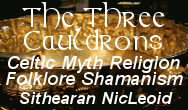Pagan Paths
Discover the natural magic of the British countryside and apply its
lessons to your life, wherever you roam.
Symbols of traditional British Old Craft: Flora and Fauna
We all have our own personal totem-power animals but there are certain flora and fauna that have special meaning with Old Craft per se. These are particular animals and plants that transcend the personal and belong to the collective awareness of Old Crafters. Some may actually be an individual’s power-animal; others may appear as messengers from Otherworld even though they are not actively considered as a personal totem. The message, however, should not be ignored if any of these creatures cross our path. For example:
The most common and most obvious are the various members of the Corvus family: crows, rooks, ravens, magpies and jays. Noisy, raucous birds whose odd behaviour may contain a warning. For cowans (i.e. non witches) these birds are considered unlucky but as with a lot of superstitions, the meaning is often reversed from the Craft perspective. The old folk-rhyme “One for sorrow, two for joy ...” is equally applicable for both crows and magpies. Magpies, jays, crows, rooks and ravens were all particularly feared if they seemed to be focussing their attention on a particular person or household – but this attention would be seen by a witch as a different kind of message.
The shy, elusive brown hare has long been synonymous with witchcraft; the emblem of the three hares joined by the ears is also an ancient image and one chosen as a logo for Coven of the Scales’ Arcanum course. As far back as Julius Ceasar writing ‘The Conquest of Gaul’, he recorded that the native Britons would not eat hare meat and attributed this to mean that the creatures were sacred; in Christian times the hare was considered unlucky and often viewed as witches in disguise. She was sacred to the goddess Eostre but in more recent times, this holy hare has been replaced by the ‘Easter bunny’.
The grass snake was considered unlucky and/or evil but its skin was nevertheless believed to have curative powers and used in a variety of domestic medicinal preparations. In traditional British Old Craft a witch would wear a snakeskin garter as a badge of rank and according to legend, this is the foundation for the origins of ancient Order of the Garter. As one historian observed: “Only at the instigation of a king as powerful as Edward III could such a famous order of chivalry have as its symbol an article of ladies’ underwear.” The story goes that the Countess of Salisbury dropped her garter and the king picked it up and placed it around his own leg – the gesture inferring that the garter was more than a simple frippery and that its significance suggests that the Countess was a witch and now under the king’s protection.
Weasels and stoats are often interchangeable but both are deemed to be unlucky and have a strong connection to Old Craft. They were probably avoided because of their ferocity but the skins were used to line cloaks and the ‘ermine’ became a badge of rank for the nobility. These ferret-like creatures often appear in old wood-cuts as witches’ familiars.
In general terms, for an Old Craft witch the completion of an outdoor spell-casting or magical working should be followed by the bark of a dog/fox; the cry of an owl/hawk, or the croak of a frog/toad to indicate that the spell had ‘gone home’. Endorsement of this sentiment can also be found in Leyland’s notes to ‘Aradia, or the Gospel of the Witches’.
And if a particular type of flora (or fauna) is listed in compendiums of superstition as being unlucky, then it’s a safe bet that there was originally a connection to witchcraft or pre-Christian beliefs. Holly, ivy, blackthorn and whitethorn are all traditional Old Craft trees and deemed unlucky in many parts of the country. The oak, however, has been adopted as a multi-cultural symbol of strength and national pride. These traditional symbols of Old Craft are with us constantly, regardless of our own personal choices, and we should recognise – and honour – them as such.
Comments
-
Please login first in order for you to submit comments



















